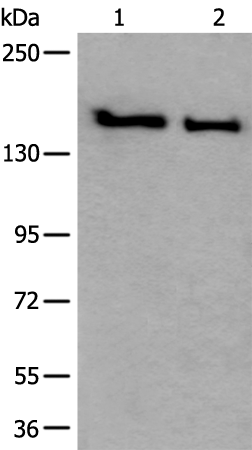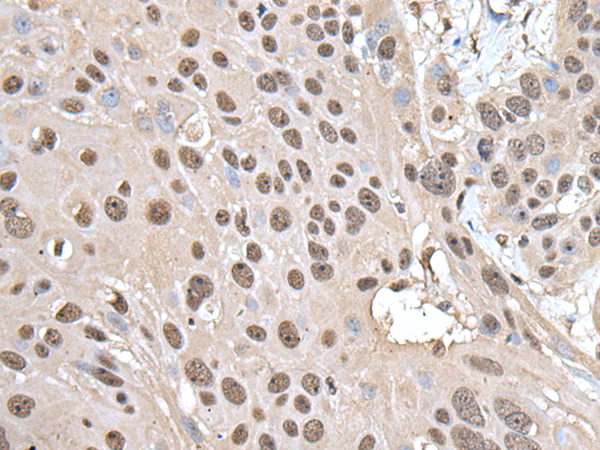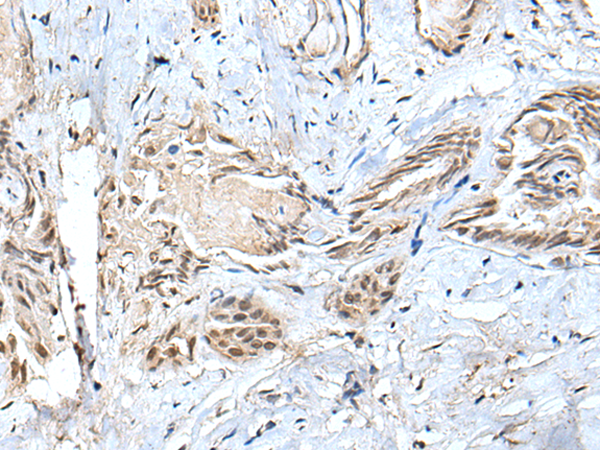


| WB | 咨询技术 | Human,Mouse,Rat |
| IF | 咨询技术 | Human,Mouse,Rat |
| IHC | 1/25-1/100 | Human,Mouse,Rat |
| ICC | 技术咨询 | Human,Mouse,Rat |
| FCM | 咨询技术 | Human,Mouse,Rat |
| Elisa | 1/5000-1/10000 | Human,Mouse,Rat |
| Aliases | SMC1; SMCB; CDLS2; SB1.8; SMC1L1; DXS423E; SMC1alpha |
| WB Predicted band size | 143 kDa |
| Host/Isotype | Rabbit IgG |
| Antibody Type | Primary antibody |
| Storage | Store at 4°C short term. Aliquot and store at -20°C long term. Avoid freeze/thaw cycles. |
| Species Reactivity | Human, Mouse, Rat |
| Immunogen | Fusion protein of human SMC1A |
| Formulation | Purified antibody in PBS with 0.05% sodium azide and 50% glycerol. |
+ +
以下是关于SMC1A抗体的3篇参考文献概览(文献标题、作者及摘要简述):
---
1. **标题**: *SMC1A mutations cause a novel severe neurodevelopmental disorder*
**作者**: Mannini L, et al.
**摘要**: 本研究通过全外显子测序发现SMC1A基因突变与神经发育异常相关,利用特异性抗体检测患者细胞中SMC1A蛋白表达下降,揭示了其在神经元分化中的关键作用(发表于 *Human Molecular Genetics*, 2020)。
---
2. **标题**: *Cohesin complex protein SMC1A binds to HIV-1 integrase and modulates viral integration*
**作者**: Rasheedi S, et al.
**摘要**: 通过免疫共沉淀(使用SMC1A抗体)发现SMC1A与HIV整合酶互作,调控病毒DNA整合至宿主基因组,为抗病毒治疗提供新靶点(发表于 *Journal of Virology*, 2016)。
---
3. **标题**: *SMC1A is part of a complex maintenance system ensuring sister chromatid cohesion*
**作者**: Musio A, et al.
**摘要**: 通过SMC1A抗体的免疫荧光实验,证明该蛋白在细胞分裂期染色单体黏连中的核心功能,突变会导致黏连缺陷和基因组不稳定性(发表于 *Nature Cell Biology*, 2006)。
---
**备注**:如需具体DOI或补充文献,可进一步提供研究方向(如疾病机制、实验方法等)。
The SMC1A antibody targets the Structural Maintenance of Chromosomes 1A (SMC1A) protein, a key component of the cohesin complex critical for chromosome organization, DNA repair, and transcriptional regulation. SMC1A, along with other cohesin subunits, ensures sister chromatid cohesion during mitosis and meiosis, maintaining genomic stability. It also facilitates chromatin loop formation, influencing gene expression. Mutations in SMC1A are linked to Cornelia de Lange syndrome (CdLS), a developmental disorder, and certain cancers, underscoring its role in cellular health.
SMC1A antibodies are widely used in research to study cohesin dynamics, chromatin architecture, and disease mechanisms. They enable detection of SMC1A expression and localization via techniques like Western blotting, immunofluorescence, and chromatin immunoprecipitation (ChIP). These tools help explore how cohesin dysfunction contributes to developmental defects or oncogenesis. Commercial SMC1A antibodies are typically validated in human or model organisms (e.g., mouse, zebrafish), supporting cross-species studies. Recent work also investigates SMC1A's post-translational modifications (e.g., phosphorylation during DNA damage responses), highlighting its regulatory complexity. As therapeutic targeting of cohesin gains interest in cancer, SMC1A antibodies remain vital for mechanistic and diagnostic research.
×